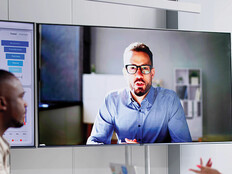Technology Helps Drive the Public Health Response
In addition to maintaining public meetings, technology has also enabled local government agencies to respond directly to the pandemic.
In Florida, a local public health agency used the Webex platform to transform its COVID-19 interactions with the public. The agency’s previous contact center solution required employees to come into a physical office and allowed them to make only one call at a time to deliver COVID test results to residents.
With Webex, the agency was able to use its existing infrastructure while gaining new functionality. For example, users could dial resident’s numbers via an automated system and get results faster while not directly viewing results, ensuring patient privacy.
Additionally, the system enabled users to make the calls while working remotely, reducing the number of people in the office to limit the spread of the virus.
DIVE DEEPER: What is the tech behind COVID tracking tools?
Legislatures Can Conduct Business Remotely
Governments can also use Legislate for Webex, a skin designed for legislatures on top of the Webex platform.
Legislate for Webex enables lawmakers to conduct hearings virtually or in a hybrid environment with specialized tools to replicate the in-person experience. For example, built-in tools manage timing for speaking and voting and other session details. Meeting participants can also set up sidebar meeting rooms where participants can chat in private and rejoin the video meeting.
The platform also allows users to set up, administer and moderate votes securely quickly. Lawmakers can create a voting agenda ahead of the session and instantly analyze the results of the vote, including customized breakdowns by party or group.
For security, in-person lobby attendant verification is built-in, meaning that unauthorized users won’t access critical votes. In addition, Cisco tools like DUO multifactor authentication and Umbrella for web security are available to secure the session further.
The tool can be used for legislators who aren’t ready to return to in-person sessions, or it could be used if legislatures need to operate remotely in the future.
RELATED: State technology directors say telework will endure past the pandemic.











